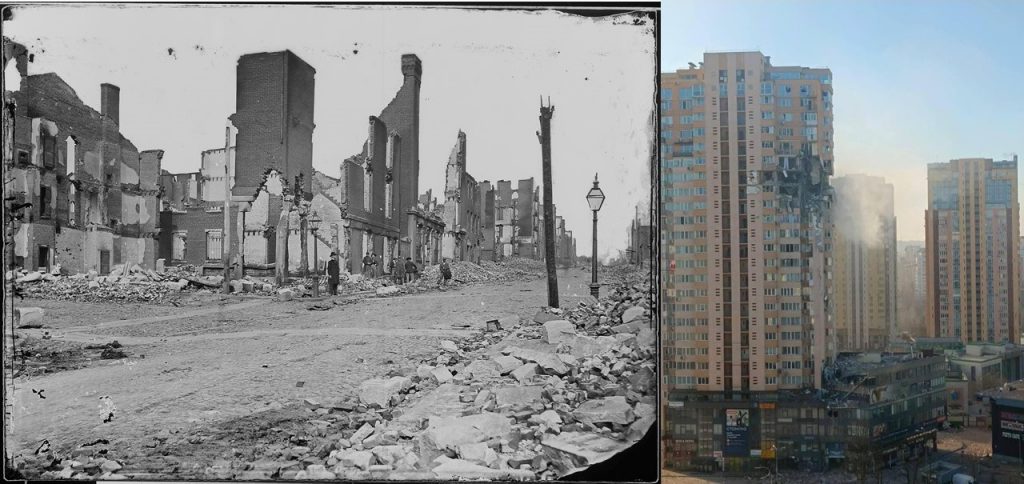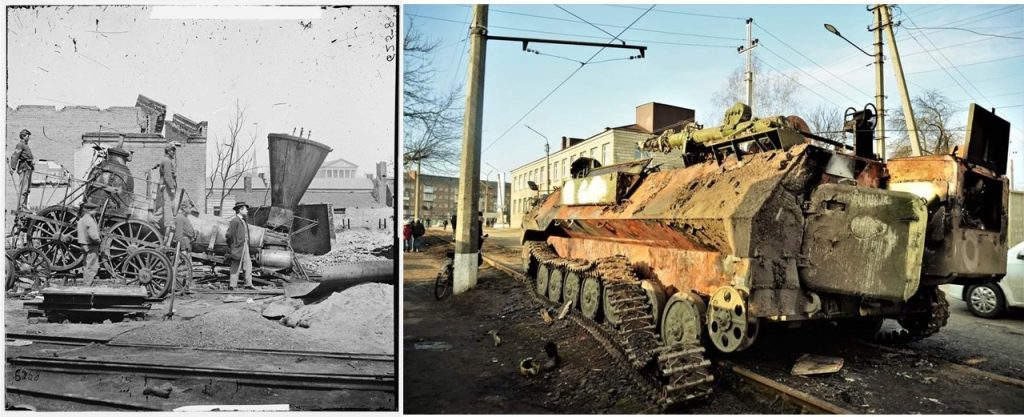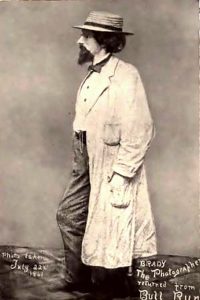The Invasion of Ukraine and the U.S. Civil War: Comparative Watersheds in Portraying War
Like many others, I have been captivated by the February 2022 Russian invasion of Ukraine. The Ukrainian people’s desire and resolve to maintain their independence has been a source of inspiration for many and has stirred global actors, ranging from nation-states to international bodies to private businesses, to take action. The deeper I looked at the conflict, I began finding numerous allegories between Ukraine’s defense against Russian incursions and the U.S. Civil War. Perhaps the most profound comparison is how both conflicts act as a watershed moment shifting how war is portrayed to the public at large.

Already, there are numerous examples of historical trends between these two conflicts. Both wars involve breakaway territories declaring independence: the Confederacy declaring independence from the United States and the Russian-backed breakaway states of Donetsk and Luhansk doing likewise from Ukraine. The question of sovereignty regarding these breakaway states will likely remain a major point of contention as the Ukrainian conflict continues, just as the case of Confederate independence was a linchpin of the U.S. Civil War.
Both conflicts targeted the trade and transportation networks of involved parties. In the Civil War, the U.S. blockade restricted access to Confederate ports while European nations maintained a loose neutrality via funneling arms and equipment to both sides in the North American conflict. In February 2022, closed European airspace and international sanctions serve the same purpose of restricting Russian trade – a Russian-flagged cargo ship was even seized by France for being suspected of violating these sanctions – while many international parties are funneling military aide to Ukraine.[i]
Because of the economic restrictions and campaigns in both conflicts, serious economic implications followed. The blockade of the Confederacy resulted in major inflation as the Civil War continued, just as the value of the Russian ruble dropped after international sanctions were implemented.[ii] There are even leadership allegories between the two conflicts. Ukrainian President Volodymyr Zelenskyy proudly answered a U.S. offer of evacuation from the Ukrainian capital of Kyiv with “I need ammunition, not a ride.”[iii] Much like Zelenskyy, U.S. President Abraham Lincoln refused to evacuate Washington D.C. in 1864 on the approach of Confederate forces under Lieutenant General Jubal Early.
The greatest similarity however is not a specific action, but how each conflict offers a watershed for changing the public portrayal of warfare. The U.S. Civil War became the first conflict extensively photographed, where citizens on the home front could see the carnage and battlefields firsthand. The Russian invasion of Ukraine is likewise the first major conflict being extensively documented by individuals tied into a globally connected high-speed internet. Though other modern conflicts pioneered this form of reporting and documentation (the Arab Spring, elements of the War on Terror, Conflict with ISIS), this conflict is being captured and responded to with higher pixels, faster internet uploads, and viral replies that seem unprecedented. Smartphones, social media, and internet platforms are showcasing the war’s progression as much as the traditional press and government releases.

Just like social media and high speed internet was not first used in the Russian invasion of Ukraine, photography was not first used in the U.S. Civil War. In fact, the first battlefield images taken were on the Crimean Peninsula in the 1850s, along the same land being fought over by Ukraine and Russia now. Those images however were not very widespread, and it was not until the Civil War the next decade that photography widely documented war. Matthew Brady and Alexander Gardner became household names across America in the 1860s, with photographs ranging from the Battle of Antietam’s aftermath to the destruction of Richmond bringing the horrors of war into people’s homes. For the first time civilians could actually see the battlefield, and it affected them a great deal. Seeing the dents in USS Monitor’s turret or the dead alongside a fence at Antietam were much more shocking and impactful than the paintings, drawings, and woodcuts used in previous conflicts. Civil War photographers ultimately documented most major campaigns from the blockade to the Trans-Mississippi, with photographs of most military and naval commanders, battlefields, large warships, and many army regiments published at the time and now widely available online.
Just as Civil War photography changed how people viewed that conflict, social media and other internet platforms are changing the portrayal of modern warfare. As Russians moved into Ukraine in February 2022, citizens and military personnel took to the internet, documenting Russian advances and Ukrainian resistance. People across the world now have access to raw video and imagery that displays the conflict practically in real time. Government groups are taking advantage of this, using social media to send out information ranging from wartime policy changes to what areas to avoid in a shelled city.

People are looking to social media platforms more than they are watching news broadcasts, and perhaps for the first time in the history of warfare, those directly involved have more agency in how war is portrayed to the home front and abroad to external states and international organizations. Just as in the U.S. Civil War with Brady’s and Gardner’s photographs, the narrative of war is being made on the battlefields themselves, as the globe bears witness to the conflict directly through the lens of its participants and the imagery and video soldiers and involved civilians upload and stream directly from their smartphones.
Both image and information watersheds have the challenge of legitimacy. In the Civil War, photographers often staged their images, and it was not beyond them to even move the dead for a more captivating shot. Social media imagery can have the same problem of legitimacy, as reports or images can come from one place but be represented as from another. To alleviate this, many news groups are looking up geotags on posted images and videos to validate their location and date of creation.

Other watersheds in the portrayal of war have also occurred over the last century. Americans watched “Why We Fight” documentaries in movie theaters throughout World War Two, melding propaganda and battlefield footage together. In the Vietnam War, reports of firefights appeared on the nightly news. As the twenty-first century dawned, footage from unmanned aerial vehicles and drones became synonymous with the Persian Gulf War and War on Terror. For me, these are major defining moments in how war was portrayed, but the Civil War’s photographs and the use of social media for the Russian invasion of Ukraine stand apart as major phase shifts in how people behind battle lines experience the horrors and trials of war directly.
Emerging Civil War describes the U.S. Civil War as America’s most defining event. Perhaps Ukraine’s resistance to Russia’s invasion is the defining moment of modern Eastern Europe. Time will tell for certain, but in the meantime, I will continue watching social media for instant updates and smartphone videos that can contextualize and humanize the conflict’s ongoing destruction, just as Americans looked on the photographs of the like of Matthew Brady and Alexander Gardner to do the same in the 1860s.
Footnotes:
[i] Bill McLoughlin, “Russian cargo ship seized by French officials in English Channel”, Evening Standard, February 26, 2022, https://www.standard.co.uk/news/world/russian-ship-baltic-leader-english-channel-france-b984837.html; Ursula von der Leyen, “Statement by President von der Leyen on further measures to respond to the Russian invasion of Ukraine”, European Commission, February 27, 2022, https://ec.europa.eu/commission/presscorner/detail/en/statement_22_1441.
[ii] Confederate economic instability, coupled with wartime setbacks, resulted in a wartime inflation which jumped to between $25 and $60 in paper for one dollar in gold. See Mark Thornton and Robert B. Ekelund Jr., Tariffs, Blockades, and Inflation: The Economics of the Civil War (Wilmington, DE: Scholarly Resources Inc., 2004), 68; Rose Razaghian, “Financial Civil War: The Confederacy’s Financial Policies, 1861-1864,” Yale University ICF Working Paper, No. 04-45, Department of Political Science, Yale University, 29; For Russian inflation in February 2022 see Thomas Franck, “Economic sanctions cripple Russian economy as ruble plunges, interest rates soar”, CNBC, February 28, 2022, https://www.cnbc.com/2022/02/28/economic-sanctions-send-russians-scrambling-for-dollars-euros-and-other-currencies-as-ruble-plunges.html.
[iii] Sharon Braithwaite, “Zelensky refuses US offer to evacuate, saying ‘I need ammunition, not a ride’”, CNN, February 26, 2022, https://www.cnn.com/2022/02/26/europe/ukraine-zelensky-evacuation-intl/index.html.
Interesting article. The Russians obviously, at the present, cannot terminate Internet access or satellite-based communication. That might change as they get more aggravated and even desperate. It’s also important to note that Ukraine was able to indeed be an independent country since the USSR’s demise, with some notable, and violent, disagreements with Russia since then. But the world today recognizes Ukraine as an independent, sovereign country in its own right, while the Confederacy never was.
We’ve learned today not to trust any photo or video, regardless if from social media or MSM (probably just re-published social media)
You are right that there is a lack of trust in imagery today. I think it is a good thing that the public asks more questions of the images they are shown today. Something tells me that there was not much questioning in the 1860s from the public on what was being taken in a Civil War photograph and whether it was a genuine shot taken or one that was staged.
I had to chuckle at the following quote from Chatelain:
“There are even leadership allegories between the two conflicts. Ukrainian President Volodymyr Zelenskyy proudly answered a U.S. offer of evacuation from the Ukrainian capital of Kyiv with “I need ammunition, not a ride.”[iii] Much like Zelenskyy, U.S. President Abraham Lincoln refused to evacuate Washington D.C. in 1864 on the approach of Confederate forces under Lieutenant General Jubal Early.”
The more obvious leadership allegory between our “Civil War” and the Ukrainian conflict is that of Putin and Lincoln. Both men deny that most basic human right as recognized in the UN Charter – the right of self-determination. Both engaged in a war of reunification for the purpose of political and economic conquest. Gorbachev begrudgingly recognized the right of secession and a government by consent of the governed, thereby avoiding the charge of a crime against humanity. Putin does not recognize that right nor care about the crime; neither did Lincoln. Lord Acton called out Lincoln for committing “an awful crime.” It is a shame someone like Gorbachev was not the American President in 1861.
Rod,
What about the self-determination of the millions of enslaved peoples? Or do you only care about the right of wealth white slaveowners to self-determine their future? Did the enslaved “consent to be governed” under your definition?
Rod, with all due respect, Gorbachev was (and he might still be) a dedicated communist who fought quite hard to keep the inevitable collapse of the Soviet Union from happening. The countries of the USSR were all sovereign countries in their own right. They reclaimed that status when the Soviet disintegration came about in the early 1990s, and the Russians themselves didn’t have the resources or the will to prevent it. Ukraine and Russia have a long, complicated, and often bloody history with each other. But, the USSR endorsed Ukraine’s entry into the UN back when the UN came about, mainly for the vote it represented there, but it was their admission that Ukraine was its own country. It was an entirely different circumstance confronting Lincoln when the USA was in danger of permanently splitting. The USA never comprised a bunch of individual countries, though the good folks in Texas might argue that. LOL.
Still waiting on the Confederacy to be recognized by one nation for its world beating Human rights record.
I sympathize with Rod’s comments. Apparently, you can join the Union, but you can never leave – although it is okay for West Virginia to secede from Virginia using a rigged convention. But I think the revolution in experiencing war was more pronounced in the Civil War. CNN was made famous by showing live video of airstrikes in the Gulf War. The Vietnam and Iraq War had its imbedded reporters. Are Youtube videos that much more revolutionary than the satellite feeds from 1991 reporters? Maybe more common, but has it changed the public’s perception of war that much from say, the Iraq War in 2006?
In fact, a more interesting question is whether all this free-ranging video is making news less reliable. Nobody doubted that what CNN showed in 1991 was real, and that it was from a trusted source (it is a shame CNN has lost that credibility and relevance). Nowadays, you can see a Youtuber showing a blasted Russian tank, but does that mean the Russians did or did not control half the city?
In regards to the Civil War, I think Brady and his photographers were considered more “entertainment.” The public used his photographic displays to see the emotional costs of war, not to understand the Battle of Antietam. The photographers rearranged bodies because they were not doing “news” but creating an emotional impact.
To be reliable news you need context with a trusted impartial source. Otherwise, it is just entertainment or propaganda. Unfortunately, it is hard to find trusted impartial sources today with US mainstream media. So maybe Brady’s photographers and today’s mainstream media and Youtubers are more similar than I thought.
Very good points John. This particular war (Russia vs. Ukraine) pinpoints much of what you say. When we see images of a blown up tank, or dead bodies that are wearing military uniforms, what exactly are we really seeing? Most of Ukraine’s military hardware is Russian-made. The combat uniforms of many if not most militaries of developed countries today look remarkably similar. The Kaiser’s distinguishing pointed helmets of WW1 are indeed a thing of the past. The plethora of devices that provide ‘instant reporting’ facilitates the ability to “play us” as much as it does to (hopefully) inform us.
What specifically are you watching on CNN from Ukraine that you consider “unreliable”? Every time they show a video, they clarify that they haven’t confirmed the accuracy of what it is unless it’s clearly fact – such as destroyed Russian vehicles containing specific Russian unit markings.
My thoughts one year in.
After 1 year, Russian leader is going thru generals like a Lincoln. He’s looking for Grant, is it possible Russian culture doesn’t create Grant’s?
Lincoln, after being told Mosby had slipped in behind Union lines, captured 50 horses and a general in Fairfax, VA: “I can always make another general, but I’m gonna miss those horses.” [ie. Subsitute Russian leader name, and tanks for horses, in 2023.]
The Russian approach is like Grant’s Overland Campaign. The numbers were in the Union’s favor and the mathematics of war allowed them to prevail. There have been many Cold Harbor’s for the invaders, but they continue oncoming.
Our war was mostly fought in the Confederacy, not counting St. Albans ;-). This one mostly fought in Ukraine, with the Ukrainian civilians, like those of the Confederacy, suffering the most. Obviously there are mothers and families on both sides that are suffering losses.
The Russians are emptying the jails to keep the invasion in progress. Lincoln instituted a draft. Grant emptied the defense of Washington to keep his momentum.
The crew races of Princeton and Yale and Harvard went on uninterrupted, I am told, during the war – the Union never had to dig that deep into its population. I suspect Moscovites are pretty much shopping normally, but maybe not enjoying a quality iced mocha latte frap with almond milk.
Grant’s seige tactics were victorious and the Russians are always trying to encircle and seige into submission the defenders.
Thus far, Ukraine is outsmarting and out tacticking the invaders just as the Confederacy out generalled and out cavalryed the Union early in the war.
The Russians are bombing, rocketing, and droning targets like Sherman firing upon Atlanta.
Lincoln at first was not surrounded by yes-men, but I suspect that is not true with Russian leader. It’s not clear to me that Russia wasn’t goaded into being the aggressor, as the Southern states felt they had no choice but to fight, I just don’t know enough about international politics over the last 30 years, but I am not eliminating that premiss.
England provided the Confederacy the CSS Alabama, now England is providing Ukraine armaments.
Watching the events unfold I can sometimes picture myself a Confederate citizen, hearing of Ukrainian successes in places that I never knew existed, and after the successes the invaders keep coming on. I’m not a fan of Russian aggression and hope the best for the big hearted people of Ukraine who surely didn’t deserve to be caught in the middle.
These were the words of future Union General James McPherson to future Confederate General Porter Alexander when they were in California at the start of the war.
“The population of the seceding states is only eight million while the North has twenty million. Of your 8 million over 3 million are slaves & may prove a dangerous element. You have no army, no navy, no treasury, no organization & practically none of the manufacturers— the machine shops, coal & iron mines & such things— which are necessary for the support of armies & carrying on war on a large scale. You are but scattered agricultural communities & will be isolated from the world by blockades. It is not possible for your cause to succeed in the end & the individual risks you must run meanwhile are very great.”
Ukraine, you positively amaze me.
And collapse came for the Confederacy suddenly and unexpectedly – just like it will for Ukraine. And the West will be shocked.